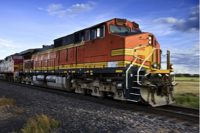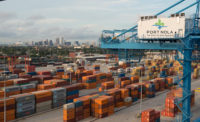Today’s high-tech advances and attention to safety allow rail intermodal to gain steam ahead.
Rail intermodal has been growing rapidly for many years. In fact, U.S. rail intermodal volume amounted to 13.5 million containers and trailers in 2014, up from just 3.1 million in 1980, according to the Association of American Railroads (AAR), Washington, D.C.
Likewise, intermodal volumes jumped 4.5% in Q2, as outlined in the second quarter “Intermodal Market Trends and Statistics” report produced by the International Association of North America (IANA), Calverton, Mo.
But, it’s today’s high-tech advances and attention to safety that allow rail intermodal to gain steam ahead.
Safety first
The freight railroad industry shares the belief that there is no greater priority than safety, says Ed Greenberg, spokesperson for AAR.
“Safety is built into every aspect of this industry and is a 24/7 focus,” he adds. “Currently, balanced regulations provide the opportunity for railroads to continue to maintain and further modernize the 140,000-mile rail system. Re-regulation is a constant threat that would prevent railroads from making the massive private investments necessary to meet our nation’s growing freight transportation needs. Railroads are constantly trying to improve service and be as responsive and efficient as possible in ever-changing markets.”
According to an AAR study on rail safety conducted in August, today’s U.S. railroads have lower employee injury rates than trucking, inland water transportation, airlines, agriculture, mining, manufacturing and construction. And, the train accident rate in 2014 was the lowest ever, down 80% from 1980 and down 44% from 2000, the report says.
That’s because rail providers like Union Pacific (UP), for example, take the necessary steps to ensure safety. In fact, UP has invested more than $31 billion from 2005-2014 to support America’s transportation infrastructure, says Nick Langel, senior business manager, marketing and sales, ag products for the Omaha, Neb., rail provider.
“This includes our rail-owned container fleet, locomotives, capacity and the infrastructure that is critical to the efficient and timely transport of freight,” he adds.
Challenges facing short lines also center around safety.
“With the swirl of regulations and legislation pending in response to recent high-profile rail accidents, ASLRRA is focused on two key areas to make our mark in improving rail safety. The leading causes behind rail accidents are related to track condition and human factors. Sponsorship of the 45G tax credit allows railroads to invest in track rehabilitation, making it safer. And, the Short Line Safety Institute is focused on instilling a strong safety culture in our segment of the industry,” says Amy Krouse, director, strategic communications for American Short Line and Regional Railroad Association (ASLRRA), Washington, D.C.
Kansas City Southern (KCS), Kansas City, Mo., and its principal U.S. subsidiary, The Kansas City Southern Railway Co. (KCSR), announced plans to invest approximately $7.5 million in 2015 on construction and improvement projects on its Aberdeen Branch between West Point and Aberdeen, Miss., and its Tuscaloosa subdivision between Artesia and Columbus, Miss., to maintain and enhance safety on KCS’ cross-border network. The project includes the replacement of 5.6 miles of rail and 38,000 cross ties, as well as improvements to 19 road crossings.
“KCS, through its U.S. and Mexican subsidiaries, continues to invest in capital projects to expand network capacity, keep maintenance in a regular and healthy cycle and enhance the safety of our operation,” said David Starling, chief executive officer, in a press release.
Getting up to speed with advanced technologies
Enhanced technologies continue to help the rail intermodal industry stay on track with the rest of the supply chain and logistics market.
For instance, UP launched Food Train Network, a dedicated service designed for customers delivering perishable products directly from agricultural regions in California and Idaho to the Northeast part of the United States.
“UP moves Food Train Network trains using a technology called ‘distributed power,’ which creates fuel efficiencies and safety benefits, reduces emissions and protects our customers’ edible cargo with a smoother cross-country ride,” says Langel. “As we expand access to rail products like Food Train Network, our customers can harness the fuel efficiencies and just-in-time service needed when moving perishable food products to markets across the country.”
UP also launched its second series of 72-foot refrigerated boxcars, equipped with the latest temperature-controlled technology, such as GPS monitoring software that keeps customers informed about the location and condition of their shipments. Food Train Network trains bypass certain UP rail yards, reducing transit times and adding assurance that products arrive to the factory fresh, according to Langel.
For its part, CSX, Jacksonville, Fla., works with Fruit Growers Express, a railroad refrigerator car leasing company, to refuel CSX boxcars and monitor performance to keep boxcars at the correct temperature setting.
“Most of today’s refrigerated boxcars can be monitored remotely for internal temperature, fuel level and global positioning, helping preserve the integrity of the product and that the cold chain is assured and documented,” says Al Deasy, director of marketing, food products.
CSX train crews also work via wireless onboard work order devices that communicate with the home data network and the customer in real time.
“We also have been providing our customers with advanced notifications regarding train delays, same-day ETAs, work order visibility and more to help our customers maintain their supply chain,” adds Deasy. “We have also pushed this visibility out to mobile platforms with apps (such as ShipCSX), so our customers have the information anytime and anywhere they need it.”
In late 2014, Canada-based Canadian Pacific (CP) introduced 200 new high-cube refrigerated units equipped with remote telemonitoring.
“These units have some of the most current rail refrigerated platforms and allow CP to respond and tailor the operation of the unit to meet our refrigerated needs and environmental challenges,” says Jacqueline Coyle, vice president, sales and marketing, intermodal. “With movements between Eastern and Western Canada, a frozen load can start out its journey with an outside temperature of 0°C in Ontario, travel through the Prairies at 20°C and arrive in British Columbia at 10°C. Remote telemetry monitoring allows CP to monitor the temperature of the unit over the duration of the shipment.”
And, as Class I railroads begin to expand their refrigerated unit train services, OmniTRAX, Denver, Colo., looks to extend its Class I reach with a door-to-door transport solution that allows shipping to begin at the loading dock.
“We look to take care of the entire process, providing shippers with online tracking through our website that is as easy as the much more expensive option of shipping by truck,” says Peter Touesnard, chief commercial officer. “Our door-to-door shipping services will allow the superior fuel efficiency of rail to be combined with the ease of trucking.”
To dramatically improve safety and efficiency, the Transportation Technology Center, Inc. (TTCI), a Pueblo, Colo.-based subsidiary of AAR, manufactured a team of high-tech advances such as wayside detectors (which identify defects on passing rail cars), tank car enhancements to help railroads reduce rail hazmat accident rates, more fuel-efficient locomotives and advanced computer modeling software that automates rail grinding schedules, forecasts construction sequencing and simulates operations.
TTCI also introduced AskRail, a web-based application that allows emergency responders to input the railcar’s ID number to immediately determine if the car is loaded or empty.
To speed cargo flow, ports are investing in digital cameras and other tracking devices on shipping containers to provide vital information about their whereabouts within the supply chain.
“At many ports, digital cameras rather than human inspectors are used at terminal gates to examine containers for mechanical fitness and check that security seals are intact. And thanks to digital systems, drivers no longer need to pull out paperwork and wait while someone checks printed information against a computer screen,” says Kurt Nagle, president and CEO of American Association of Port Authorities (AAPA), Alexandria, Va. “At ports utilizing this technology, a digital camera can identify the unit number of the container, match it automatically with the advanced billing data that has been entered into the system, and in some cases, immediately tell the driver where to go within the marine terminal to discharge his or her load.”
Freight rail will continue to carry the economy forward, according to AAPA’s 2015 Outlook report. Freight railroads will hire an estimated 15,000 employees this year. Some of the nation’s major freight railroads will spend an estimated $29 billion to build, maintain and grow the rail network, says Nagle. And, port authorities and their private-sector partners are making major investments in adding or improving on-dock rail facilities to increase the velocity of goods moving through America’s ports.
“Rail has tremendous inherent advantages, such as fuel efficiency and the ability to move large quantities with a minimal number of crew members,” says Kevin McKinney, director of refrigerated marketing for Iowa Pacific Holdings, LLC, Chicago. “One refrigerated rail car can hold 3-4 truckloads of product, and one train can move over 100 intermodal and railcars representing the equivalent of several hundred trucks. By developing more terminals, faster, dependable service and providing competitive pricing, rail should expect substantial growth in the transportation of temperature-controlled freight.”







